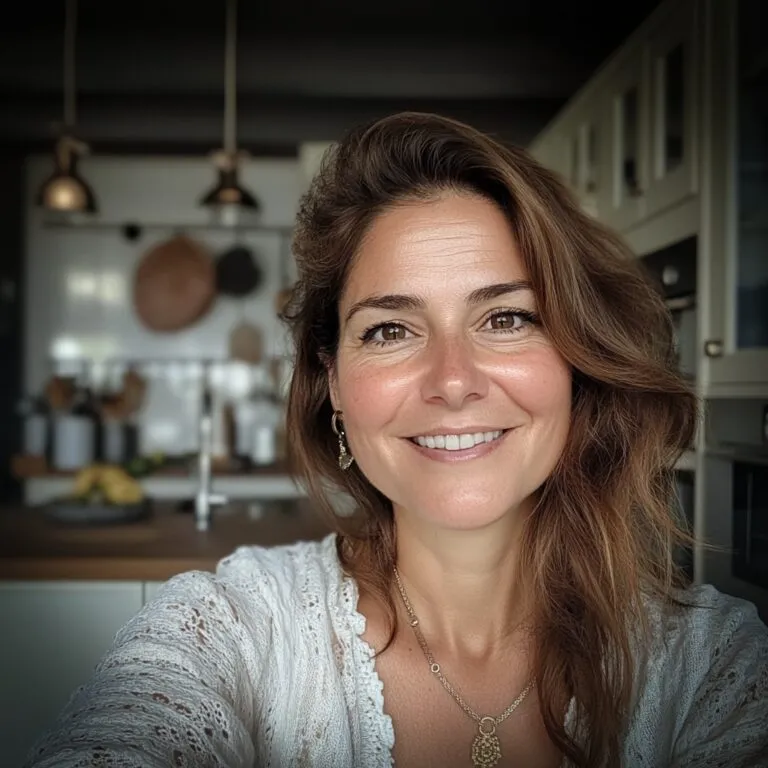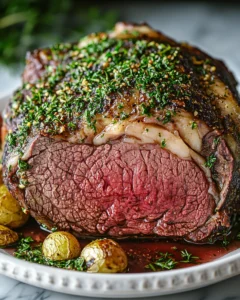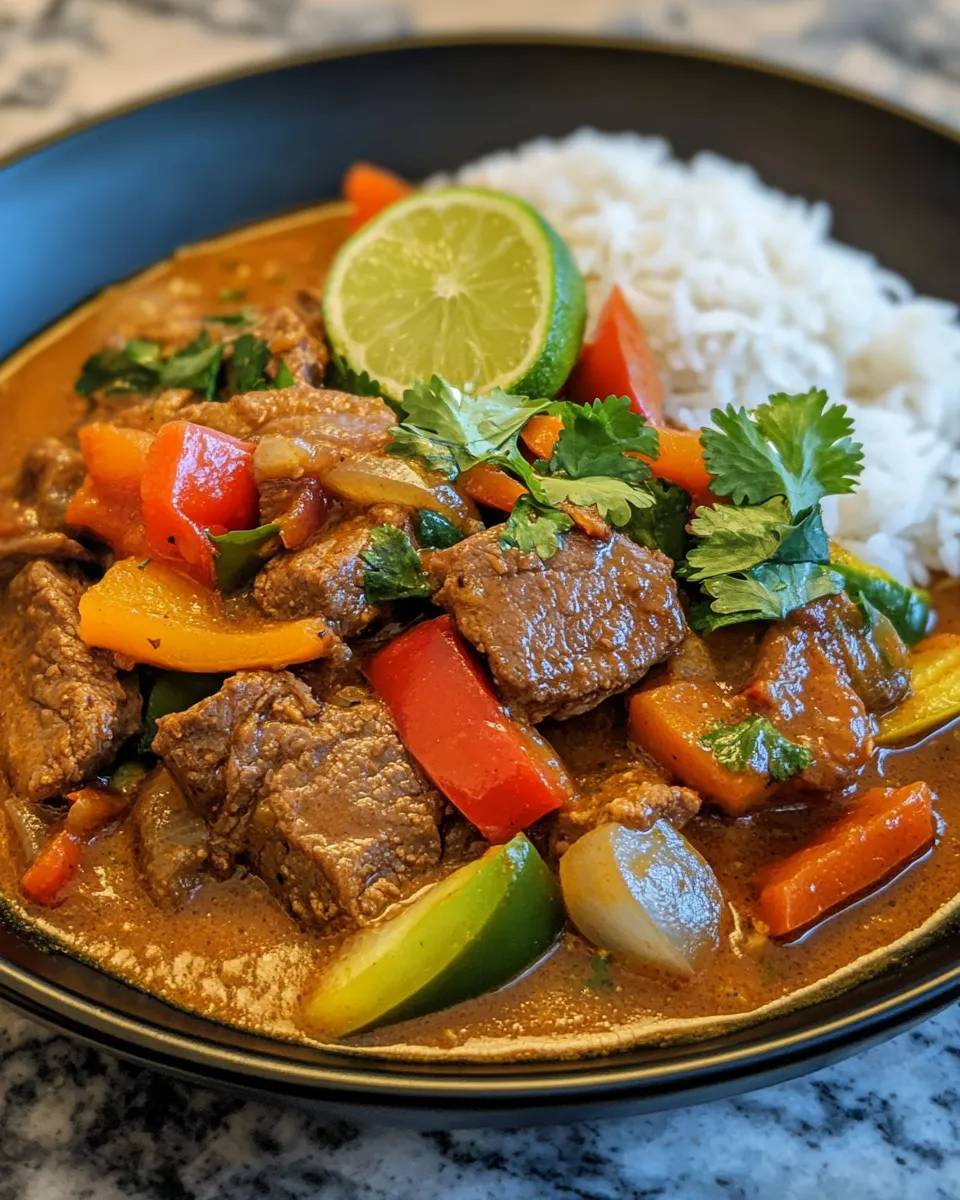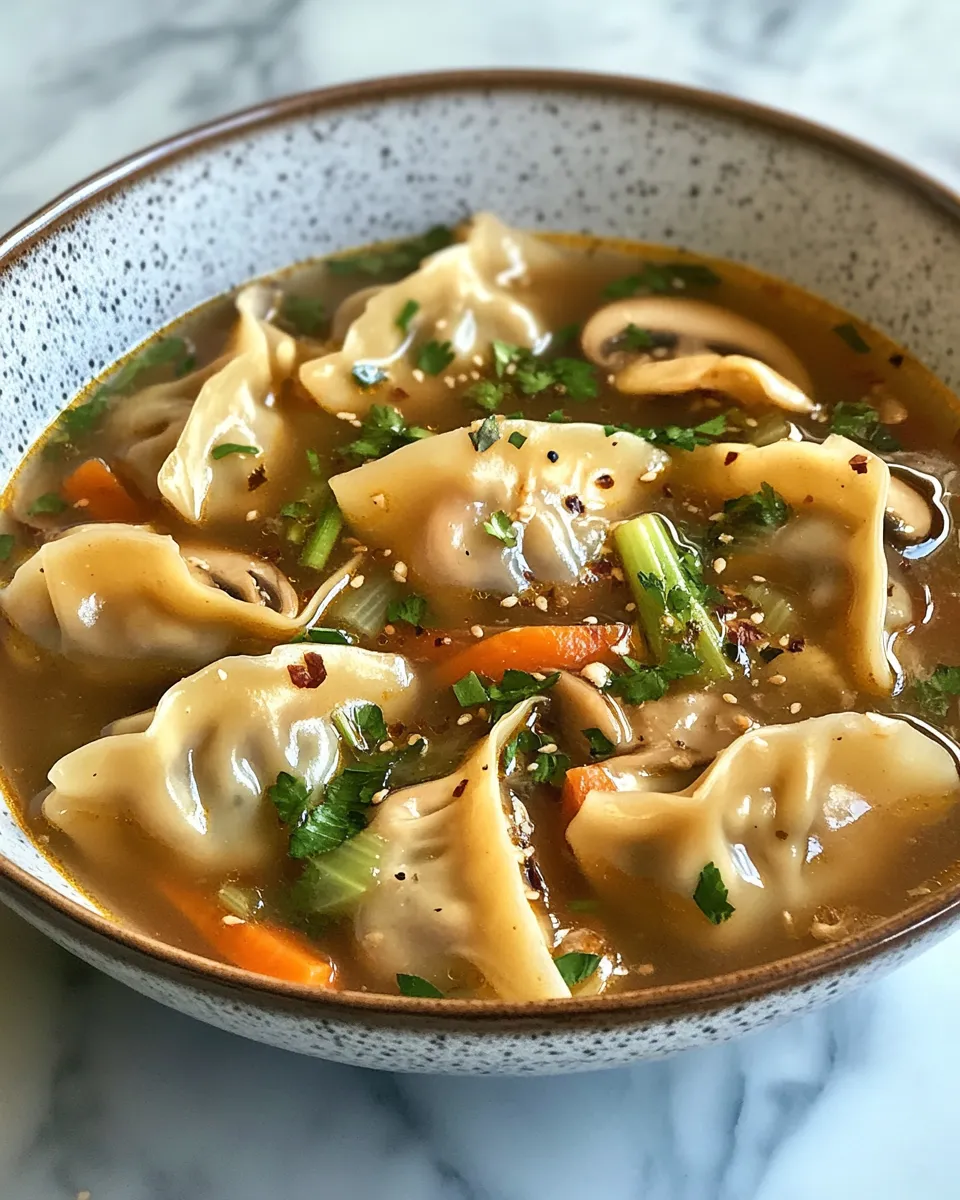There’s something undeniably special about a perfectly cooked prime rib roast. Its tender, juicy interior, paired with a crispy, flavorful crust, makes it the centerpiece of any memorable meal. Whether it’s a festive holiday dinner, a celebratory weekend gathering, or a cozy winter evening, this Buttery Herb-Seared Prime Rib Roast elevates the occasion to something extraordinary.
The inspiration for this recipe comes from generations of family traditions where the prime rib was reserved for moments worth celebrating. Slow-roasting the beef while layering it with fragrant herbs and rich butter creates a depth of flavor that rivals any restaurant-quality cut. It’s the kind of dish that fills your home with an irresistible aroma, encourages lingering conversation at the table, and has everyone reaching for seconds—and sometimes even thirds.
This recipe is designed to be approachable yet impressive. Even if you’re preparing a prime rib for the first time, following these steps will ensure a roast that’s tender, juicy, and bursting with buttery, herby goodness. By the end of this article, you’ll not only have a foolproof recipe but also tips and techniques that turn your kitchen into a prime rib haven.
Ingredients
-
1 (5–6 pound) prime rib roast, bone-in or boneless
-
4 tablespoons unsalted butter, softened
-
4 cloves garlic, minced
-
2 tablespoons fresh rosemary, finely chopped
-
2 tablespoons fresh thyme, finely chopped
-
1 tablespoon fresh parsley, finely chopped
-
1 tablespoon olive oil
-
2 teaspoons salt
-
1 teaspoon freshly ground black pepper
-
1 teaspoon onion powder
-
Optional: vegetables for roasting, such as carrots, onions, and potatoes
Directions
1. Prepare the Prime Rib
Remove the prime rib from the refrigerator at least one hour before cooking to allow it to reach room temperature. This ensures even cooking and helps the roast maintain a juicy interior. Pat the meat dry with paper towels to remove any excess moisture, which will help the seasoning adhere better.
2. Make the Herb Butter
In a small bowl, combine softened butter, minced garlic, chopped rosemary, thyme, and parsley. Add a pinch of salt and black pepper, mixing until fully incorporated. This herb butter will create the signature crust that makes this prime rib unforgettable.
3. Season the Roast
Drizzle the prime rib with olive oil and rub it over the entire surface. Generously season the meat with salt, pepper, and onion powder. Then, massage the herb butter into the meat, making sure every inch of the roast is coated. For an extra layer of flavor, carefully lift the fat cap and rub some butter directly onto the meat beneath it.
4. Preheat the Oven
Preheat your oven to 450°F (230°C). A high initial temperature helps create a beautifully seared exterior while locking in the juices.
5. Roast the Prime Rib
Place the prime rib on a rack in a roasting pan, fat side up. Insert an oven-safe meat thermometer into the thickest part of the roast, avoiding the bone. Roast at 450°F for 15–20 minutes to form a golden-brown crust.
Reduce the oven temperature to 325°F (165°C) and continue roasting. For medium-rare, cook until the internal temperature reaches 125–130°F (51–54°C). This will take approximately 1.5–2 hours, depending on the size of your roast.
6. Rest the Meat
Remove the roast from the oven and tent it loosely with aluminum foil. Allow it to rest for at least 20–30 minutes. Resting is crucial because it allows the juices to redistribute throughout the meat, ensuring each slice is tender and succulent.
7. Optional Roasted Vegetables
While the roast rests, you can roast vegetables in the same pan to soak up the flavorful drippings. Toss carrots, onions, and potatoes with olive oil, salt, and pepper, then roast at 400°F (205°C) for 25–30 minutes until tender and caramelized.
8. Carve and Serve
Use a sharp carving knife to slice the prime rib against the grain. Serve with roasted vegetables or your favorite sides, and drizzle with any pan juices for an added layer of flavor. The result is a golden crust with a melt-in-your-mouth interior that will impress everyone at the table.
Tips for the Perfect Prime Rib Roast
-
Choosing the Right Cut: Opt for a prime rib roast with good marbling, as the fat contributes to tenderness and flavor. Bone-in roasts tend to cook more evenly and retain moisture better, but boneless roasts are easier to carve.
-
Season Ahead: For maximum flavor, season the roast with the herb butter up to 24 hours in advance. Wrap tightly and refrigerate, then bring to room temperature before roasting.
-
Use a Thermometer: Avoid guessing doneness. A meat thermometer is essential for perfect results and prevents overcooking.
-
Let it Rest: Never skip the resting step. Cutting into the roast immediately will cause the juices to escape, leaving the meat less juicy.
-
Pan Drippings: Use the flavorful drippings to make a quick jus or gravy. Deglaze the pan with a little beef broth or water, scraping up the browned bits for a rich sauce.
Prep Time, Cook Time, Total Time, Yield
-
Prep Time: 30 minutes (plus 1 hour for room temperature)
-
Cook Time: 1 hour 45 minutes–2 hours
-
Total Time: 2 hours 15 minutes–2 hours 30 minutes
-
Yield: 8–10 servings
Notes
-
Use a heavy-duty roasting pan for best results.
-
Fresh herbs provide a brighter flavor than dried, but dried can be used in a pinch.
-
Leftover prime rib makes excellent sandwiches, salads, or hash.
-
Always carve against the grain for maximum tenderness.
-
Adjust cooking times for larger or smaller roasts; the meat thermometer is your best guide.
Pairing Suggestions
This Buttery Herb-Seared Prime Rib Roast pairs beautifully with classic side dishes that balance richness with freshness. Consider serving with:
-
Garlic mashed potatoes
-
Creamed spinach or sautéed green beans
-
Roasted root vegetables like carrots, parsnips, and Brussels sprouts
-
A simple mixed green salad with a light vinaigrette
For a festive table, add a warm, crusty bread or soft dinner rolls to soak up any pan juices.
Why This Recipe Works
This recipe combines tried-and-true techniques with thoughtful touches that elevate your prime rib to extraordinary. By using a high initial roasting temperature, the meat develops a caramelized crust that locks in the juices. The herb butter not only infuses flavor but also keeps the meat tender and moist. Resting the roast is a crucial step that ensures every slice is perfectly juicy and flavorful.
The combination of fresh herbs, garlic, and butter creates a profile that’s deeply satisfying without being overpowering. You get the richness of the meat, the fragrance of fresh herbs, and the smoothness of butter all in one bite. It’s a recipe that’s impressive enough for holidays yet approachable enough for any special dinner.
Common Mistakes to Avoid
-
Skipping Room Temperature: Cooking the roast straight from the fridge can lead to uneven cooking. Always allow it to sit at room temperature for at least an hour.
-
Not Using a Thermometer: Relying on guesswork may result in undercooked or overcooked meat. A thermometer ensures precision.
-
Overcrowding the Pan: If you’re roasting vegetables alongside the meat, ensure they have space. Overcrowding can prevent proper caramelization.
-
Cutting Too Soon: Resting is non-negotiable. Cutting too early causes juices to escape, resulting in a drier roast.
-
Undersalting: Don’t be shy with salt. It enhances the natural flavor of the beef and brings out the aromatic notes from the herbs.
Frequently Asked Questions
Can I cook the prime rib without the bone?
Yes. Boneless roasts are easier to carve and still deliver great flavor. Adjust cooking time slightly, as boneless roasts may cook a bit faster.
How do I know when the prime rib is done?
Use a meat thermometer. For medium-rare, the internal temperature should reach 125–130°F (51–54°C). Remember that the temperature will continue to rise slightly while resting.
Can I prepare this roast ahead of time?
Absolutely. You can apply the herb butter the night before, cover tightly, and refrigerate. Bring to room temperature before roasting.
What sides go best with prime rib?
Roasted vegetables, creamy mashed potatoes, sautéed greens, and a fresh salad complement the richness of prime rib perfectly.
How do I store leftovers?
Wrap tightly in aluminum foil or an airtight container and refrigerate for up to 4 days. Reheat gently in the oven to preserve juiciness.
Conclusion
This Buttery Herb-Seared Prime Rib Roast is more than just a meal; it’s an experience. The aroma, the presentation, and the flavor all work together to create a dish that’s unforgettable. Whether you’re celebrating a special occasion or simply want to treat your family to something extraordinary, this recipe delivers every time.
With the detailed steps, tips, and tricks provided, even a first-time cook can achieve a roast that rivals top-tier restaurants. The rich herb butter, golden crust, and tender interior combine to create a flavor profile that’s universally loved. Pair it with classic sides or get creative with your favorite vegetables and sauces, and you’ll have a centerpiece that impresses and delights every guest.
Make this Buttery Herb-Seared Prime Rib Roast the star of your next dinner, and enjoy the satisfaction of creating a meal that’s both comforting and celebratory. The beauty of this recipe is that it’s versatile, reliable, and irresistibly delicious—a perfect way to turn any gathering into a memorable feast.
Print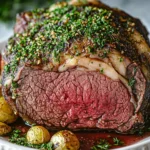
The Best Buttery Herb-Seared Prime Rib Roast Ever
- Total Time: 2 hours 15 minutes–2 hours 30 minutes
- Yield: Serves 8–10 1x
Description
A perfectly cooked prime rib is the ultimate centerpiece for any special occasion. This recipe combines a tender, juicy interior with a crispy, flavorful herb-butter crust. Ideal for festive dinners or cozy gatherings, it fills your home with irresistible aromas and creates a meal your family and friends will remember.
Ingredients
-
1 (5–6 pound) prime rib roast, bone-in or boneless
-
4 tablespoons unsalted butter, softened
-
4 cloves garlic, minced
-
2 tablespoons fresh rosemary, finely chopped
-
2 tablespoons fresh thyme, finely chopped
-
1 tablespoon fresh parsley, finely chopped
-
1 tablespoon olive oil
-
2 teaspoons salt
-
1 teaspoon freshly ground black pepper
-
1 teaspoon onion powder
-
Optional: vegetables for roasting, such as carrots, onions, and potatoes
Instructions
-
Remove the prime rib from the refrigerator at least one hour before cooking to allow it to reach room temperature. Pat dry with paper towels.
-
In a small bowl, combine softened butter, garlic, rosemary, thyme, and parsley. Add a pinch of salt and black pepper, mixing until fully incorporated.
-
Drizzle olive oil over the roast and rub it over the entire surface. Generously season with salt, pepper, and onion powder, then massage the herb butter into the meat.
-
Preheat the oven to 450°F (230°C).
-
Place the prime rib on a rack in a roasting pan, fat side up. Roast at 450°F for 15–20 minutes to form a crust.
-
Reduce the oven temperature to 325°F (165°C) and continue roasting until the internal temperature reaches 125–130°F (51–54°C) for medium-rare, about 1.5–2 hours depending on size.
-
Remove from the oven and tent loosely with foil. Rest for 20–30 minutes.
-
Optional: Roast vegetables in the same pan while the meat rests. Toss with olive oil, salt, and pepper, then roast at 400°F (205°C) for 25–30 minutes.
-
Carve the prime rib against the grain and serve with pan juices and roasted vegetables.
Notes
-
Use a heavy-duty roasting pan for best results.
-
Fresh herbs give brighter flavor; dried can be used in a pinch.
-
Resting the roast ensures juices are redistributed.
-
Leftover prime rib works well in sandwiches, salads, or hash.
-
Carve against the grain for maximum tenderness.
- Prep Time: 30 minutes (plus 1 hour for room temperature)
- Cook Time: 1 hour 45 minutes–2 hours
